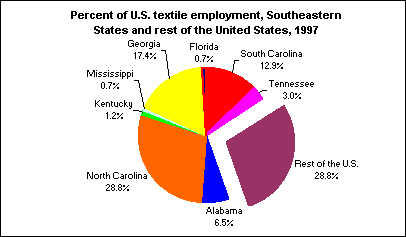An official website of the United States government
 United States Department of Labor
United States Department of Labor
In 1997, textile plants in the Southeast region of the United States had 438,300 employees, or more than 70 percent of the Nation’s textile workers. North Carolina dominated the industry with 29 percent of total U.S. textile employment—as much as the combined textile employment of all States outside the Southeast region. Georgia and South Carolina also had large textile employment shares.

[Chart data—TXT]
Despite the large number of textile workers in the Southeast, the industry’s employment declined 12,400 in the region, or about 3 percent, from 1996 to 1997. National employment in the textile industry fell 1.8 percent, from 627,000 to 616,000. The employment declines reflect, perhaps, the continued movement of jobs to lower wage areas.
Within the Southeast region, Kentucky had the largest percent decrease at 11 percent, and decreases also occurred in Georgia, South Carolina, and Tennessee. Mississippi’s textile employment increased 10 percent over the year.
These data are products of the Current Employment Statistics program. Obtain more information from "Issues in Labor Statistics: The Southeast is Maintaining its Share of Textile Plant Employment," Summary 99-2.
Bureau of Labor Statistics, U.S. Department of Labor, The Economics Daily, Southeast region employs the most textile workers at https://www.bls.gov/opub/ted/1999/mar/wk3/art04.htm (visited December 11, 2025).

